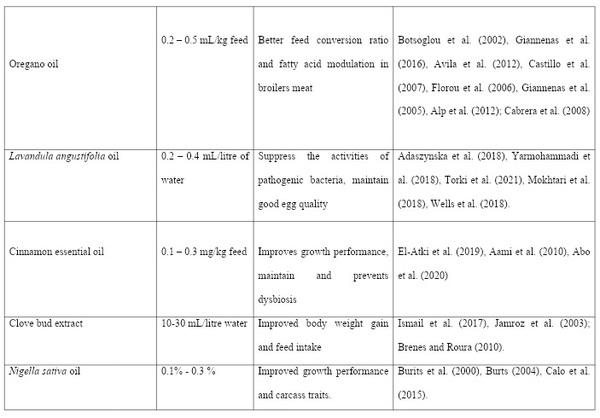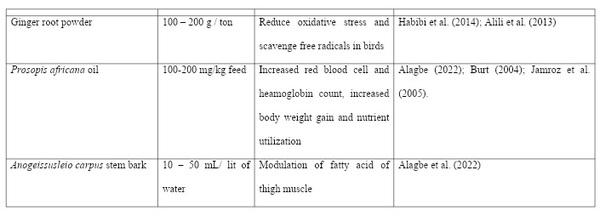Use of Medicinal Plants as a Panacea to Poultry Production and Food Security: a Review
Published: April 25, 2022
By: Alagbe, J.O. / Department of Animal Nutrition and Biochemistry, Sumitra Research Institute, Gujarat, India.
INTRODUCTION
Medicinal plants are reservoirs of bioactive compounds used by humans since early ages in traditional medicine for the treatment and prevention of diseases due to their therapeutic potential (Arun and Varsha, 2014; Dilfuza et al., 2015). According to Oluwafemi et al. (2020); Adewale et al. (2020), there are over 500,000 species of medicinal plants identified globally which has led to the discovery of novel drugs or new pharmaceuticals used for the treatment of various diseases in animals. Recently, the use of medicinal plants is increasingly gaining interest due to the increasing cases of antimicrobial resistance due to the indiscriminate use of antibiotics which has led to increased risk of resistant pathogenic bacteria, environmental pollution and toxic residue in animal products which have negative effect on human health and animals (Shittu et al., 2021). The presence of phytochemicals in medicinal plants is generally regarded as safe, effective and natural potential alternatives to produce healthy animals (Alagbe, 2021; Singh et al., 2021). Phytochemicals in medicinal plant possess enormous scaffolds that are mimicked in the design of most molecular stuctured synthetic drugs (Mishra and Tiwari, 2011) or even modified further to enhance a drug’s biological activity profile (Itokawa et al., 2008). Thus, there has been a renewed interest in investigating natural products as leads for new biologically friendly, therapeutic drug candidates (Mishra and Tiwari, 2011).
The European Union in 2009 placed a ban on the use of antibiotic growth promoters in animals due to the problems outlined above to promote food safety. According to European surveillance report in 2021 on antimicrobial consumption, European countries have substantially reduced the use of antimicrobials for animals. According to Eckel (2020), healthy animals are the foundation for healthy people and healthy people are the basis for a stable and productive society. Plant based natural constituents can be derived from leaves, stems, flowers, roots, twigs and seeds (Agubosi et al., 2022). They have become a source of drugs and are traditionally used for the treatment of numerous diseases in animals such as gastro-intestinal infection, fever, cough, pneumonia, inflammations, skin infections, mental retardation, arthritis, urinary infections and asthma (Šarić-Kundalić, 2010; Voon et al., 2012; Philander, 2011).
Medicinal plants can be incorporated into animal feed or water to enhance productivity due to the presence of phytochemicals (tannins, flavonoids, terpenoids, alkaloids, saponins, phenols or bioactive compounds (Agubosi et al., 2022) whose concentration vary according to the method of processing or extraction, geographical origin, environmental factors, harvesting seasons and storage conditions (Gadde et al., 2017). The presence of phytochemicals enables plants to perform multiple biological activities such as: antimicrobial, antifungal, antiviral, antibacterial, antioxidant, hepato-protective, chemopreventive, neuroprotective, immune-modulatory, antispasmodic, anagelsics and hypolipidemic (Alagbe, 2021). According to Dhan et al. (2012), phytochemicals are non-nutritive plant chemicals that have either defensive or disease protective properties. For instance, flavonoids are capable of scavenging free radicals and also posse’s anti-inflammatory properties (Okwu et al., 2004; Omolere and Alagbe, 2020). Generally, the ability of flavonoids to effectively act as antioxidants depends on a number of factors, i.e., metal-chelating potential that strongly depends on hydroxyls and carbonyl groups arrangement around the molecule, the hydrogen or electron-donating substituent’s present and able to reduce free radicals, and the flavonoid’s ability to delocalize unpaired electron which lead to stable phenoxyl radical formation (Seelinger et al., 2008; Gülçin, 2012; Alagbe and Motunrade, 2019).
According to Asl and Hosseinzeh (2008); Atamgba et al. (2015), saponins are useful adjuvants during the production of vaccines and they also have potentials as fertility agents. Tannins are a very complex group of plant secondary metabolites, which are soluble in polar solution and are distinguished from other polyphenolic compounds by their ability to precipitate proteins (Silanikove et al., 2001; Alagbe et al., 2021). They can be grouped into either condensed or hydrolyzable tannins. Condensed tannins are more widely distributed in higher plant species than the hydrolysable ones and they are capable of precipitating proteins (Dykes et al., 2005). Tannins are also known to posses’ antibacterial and antiviral activities and type of tannins synthesized by plants vary considerably depending on plant species, stage of development and environmental condition (Cornell, 2005; Enzo, 2007; Alagbe, 2019). Steroids are considered as great potentials for growth and bone marrow stimulation in the body of animals (Tsado et al., 2015; Alagbe, 2019).
Phenolic acids are derivatives of benzoic or cinnamic acids derivatives to form hydroxybenzoic and hydroxycinnamic acids, respectively (Dykes and Rooney, 2006). They are antioxidants which are capable of reducing oxidative stress in animals (Shittu et al., 2021; Alagbe et al., 2019). Oxidation is the transfer of electrons from one atom to the other essential for cell metabolism with O 2 as an electron acceptor releasing energy in the form of ATP. It however, becomes problematic when electron flow becomes uncoupled causing the transfer of unpaired single electrons instead of paired ones, generating free radicals (Peréz and Aguilar, 2013; Musa et al., 2020). The generated reactive free radicals containing O 2 are known as reactive oxygen species (ROS), oxidants or pro-oxidants as reported by Gülçin (2012). They include hydroxyl (HO), superoxide (O - ) peroxyl (ROO), alkoxyl (RO) and nitric oxide (NO) (Nikolova, 2012; Shittu and Alagbe, 2020). Phenols are antioxidants capable of preventing degenerative diseases such as cancer, coronary atherosclerosis and Alzheimer’s disease (Nikolova, 2012; Uddin et al., 2014) and protecting cellular components against oxidative damage (Halliwell and Evans, 2001; Dudonnѐ et al., 2009). Dietary antioxidants have been defined as any substance that when present in low concentrations than that of the oxidizable substrate, significantly delays or inhibits the oxidation of that substrate (Halliwell, 2007). Phytates are capable of interfering with minerals making them biologically unavailable for absorption (Alagbe et al., 2020). High oxalate diet can increase the risk of renal calcium absorption and has been implicated as a source of kidney stones (Chai and Liebman, 2004; Alagbe, 2019). Alkaloids in plants possess medicinal benefits which includes anti-malarial, antibacterial and anticancer activities (Sexena et al., 2013; Olufunmiso et al., 2017). Terpenoids have also been reported to posse’s antimicrobial, anti-carcinogenic and anti-diruetic properties (Oluwafemi et al., 2022; Alagbe et al., 2020).
In view of the abundant potential in medicinal plants, this review is a collection of different herbs, its inclusion level as well as its effect in poultry production.





CONCLUSION
Medicinal plants or herbs have been reported to contain phytochemicals or bioactive chemicals (alkaloids, flavonoids, tannins, terpernoids, saponins, phenols etc.) and also loaded minerals, vitamins, amino acids and other nutrients. They have also been reported to be cheap, safe and effective without having causing any negative effect on the health of an animal. Various plant bioactive compounds that play a significant defensive role against herbivory and pathogen attack, inter-plant competition, and abiotic stresses (Biswal et al., 2012) can be utilized for therapeutic purposes (Briskin, 2000; Olafadehan et al., 2020). This is because, plant phytochemicals possess enormous scaffolds that are mimicked in the design of most molecular stuctured synthetic drugs (Mishra and Tiwari, 2011) or even modified further to enhance a drug’s biological activity profile (Itokawa et al., 2008).
Related topics:
Authors:
Recommend
Comment
Share

Would you like to discuss another topic? Create a new post to engage with experts in the community.








.jpg&w=3840&q=75)